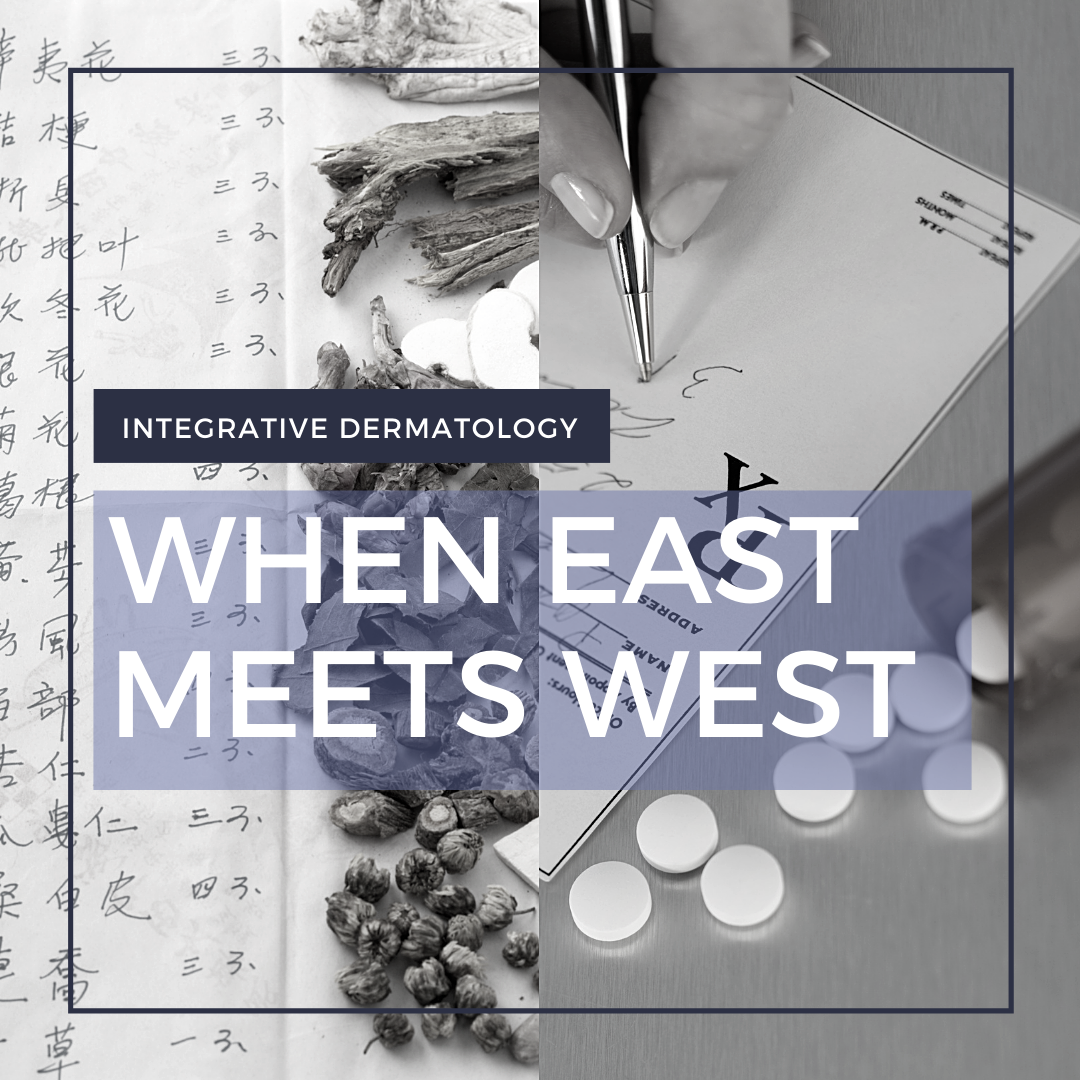To kick off the recent 2020 Integrative Dermatology Symposium, Drs. Peter Lio and Olivia Hsu Friedman, with the assistance of Ms. Kelly Barta, provided a fast-paced and comprehensive primer on how integrating conventional Western medicine with Traditional Chinese Medicine (TCM) and other Eastern approaches can serve to maximize outcomes for patients. Read on for some important takeaways to integrate into your own practice!
Ms. Kelly Barta began the presentation with a candid description of her own personal struggle with atopic dermatitis. Diagnosed with eczema in childhood, Ms. Barta underwent a traditional Western medicine treatment arc that relied on topical steroidal and non-steroidal medications, and while her symptoms were somewhat improved, she, unfortunately, experienced steroid atrophy of the skin and other well-documented adverse effects of long-term topical steroid use. Hoping to make a change, she discontinued topical steroids, but in the process experienced topical steroid withdrawal syndrome, a poorly understood and often misdiagnosed condition that occurs when long-term topical steroids are stopped. Now, with the help of Dr. Olivia Hsu Friedman, Ms. Barta has been able to effectively manage her symptoms through a combination of Traditional Chinese medicine and traditional Western practices.
With this success story in mind, Drs. Lio and Friedman further discussed pearls to improve patient outcomes through integrative care.
INTEGRATION PEARL #1 – TEAMWORK MAKES THE DREAM WORK
There are many situations in which an integrative plan of care should be considered:
-
- Pharmacologic therapy is working, but the patient describes undesirable side effects (such as skin atrophy) or residual skin issues (for example, stubborn areas of atopic dermatitis)
- Traditional Chinese Medicine or other Eastern approaches are working, but the patient needs something more immediate to manage flares
- Dr. Friedman counsels that TCM often takes weeks to become effective, and patients may need traditional Western medicine “rescue medication” such as topical steroids to bridge the gap
- Pharmacologic therapy is working, but the patient does not want to continue forever
- Dr. Lio frequently advises patients that true “cures” are hard to come by, and integrating TCM into the treatment regimen may reduce or fully obviate the need for pharmacologic therapy
INTEGRATION PEARL #2 – THE SUN RISES IN THE EAST
Traditional Chinese Medicine and other Eastern approaches offer excellent adjunctive therapy alternatives to conventional Western medicine:
-
- The patient has exhausted all pharmacologic avenues and needs another option
- TCM Dermatology practitioners are trained in the use of herbs, and Dr. Friedman can customize highly tailored treatment regimens directed at the patient’s chief complaint
- The patient is sensitive to pharmacologic interventions or experiences an adverse reaction
- The patient has tried introductory pharmacologic interventions but is not ready for biologic or other immunosuppressive therapy
- Jumping from topical therapies to “big gun” oral or injectable therapies can represent a paradigm shift for patients, and TCM offers an alternative
- The patient only wants a natural solution
- Dr. Friedman describes how the herbal medications used in TCM are purified and standardized, providing a consistent and reproducible therapeutic endpoint
- The patient has exhausted all pharmacologic avenues and needs another option
INTEGRATION PEARL #3 – THE SUN SETS IN THE WEST
In kind, conventional Western medicine therapies can be used to adjunct Traditional Chinese Medicine or other Eastern approaches in certain situations:
-
- The patient cannot pay cash but has insurance
- Unfortunately, TCM is very often not covered by insurance, whereas traditional Western therapies may be available
- The patient is sensitive to TCM interventions or experiences an adverse reaction
- The patient has exhausted all TCM interventions and needs another option
- Just as some patients reach the “end of the road” with Western medicine, some patients may not achieve full success with TCM
- The patient cannot pay cash but has insurance
INTEGRATION PEARL #4 – YIN AND YANG
As we have discussed, Traditional Chinese Medicine and conventional Western medicine are truly complementary, and the strengths of each approach can be used to augment the strengths of the other.
-
- Traditional Chinese Medicine views the skin as a “mirror” to overall systemic health, and Dr. Friedman emphasizes that TCM is often effective at treating not only the skin but also systemic comorbidities that may be underlying the condition. Dermatologic conditions can often have devastating emotional and psychological effects on patients, and TCM seeks to holistically address these effects within the overall plan of care.
- Complementing this holistic approach, Dr. Lio details how conventional Western medicine can often provide “hard data” necessary for optimized patient care. This can include specific lab or imaging evaluations, as well as soft tissue biopsies for histopathologic correlation and full body skin exams to rule out associated cutaneous malignancy.
At the end of the day, achieving the best patient outcome is always the goal. Integrative dermatologic care offers more options for patients and gives providers more knowledge of different dermatology approaches and more opportunities to work together. Consider exploring integrative care in your practice!
The above article was written by Dr. Matthew Willett, MD (DIRAC member) and represents his interpretation of the information presented by Drs. Peter Lio and Olivia Hsu Friedman during their lecture “Integrating the Dermatology Profession: Maximizing Patient Options & Care” at the 2020 Integrative Dermatology Symposium. Views expressed are those of Dr. Willett and do not reflect the official policy or position of the DON, DOD or USG.
Did you enjoy this article? Find more on Alternative Therapies here.

